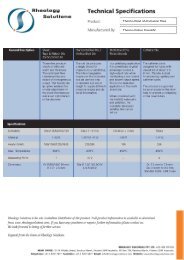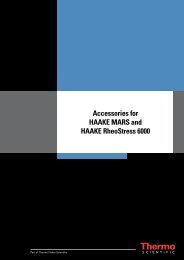Download - Rheology Solutions
Download - Rheology Solutions
Download - Rheology Solutions
Create successful ePaper yourself
Turn your PDF publications into a flip-book with our unique Google optimized e-Paper software.
application notes & technical articles<br />
Correlation Between Mixer Tests<br />
and the Extrusion Behaviour of<br />
PVC Dry Blends<br />
Abstract<br />
This report describes the correlation between<br />
measurements done on a laboratory mixer with<br />
PVC Dry Blends and their processing behaviour<br />
on a counter-rotating twin screw extruder.<br />
Introduction<br />
On July 1st, 2006, the EU Directive 2002/95/EG<br />
(RoHS-Directive, Restriction of Hazardous<br />
Substances“) was put into force. It restricts<br />
producing and trading of products containing i.e.<br />
lead, mercury and cadmium.<br />
Because a lot of PVC compounds still contain<br />
lead as stabilising media, there is urgency for the<br />
PVC industry to replace these stabilisers by less<br />
dangerous materials like CaZn stabilisers.<br />
Changing the formulation of a PVC compound by<br />
using a new stabiliser, always takes the risk that<br />
also the production behaviour will change. The<br />
reason behind this is the fact that stabilisers also<br />
work as a lubricant. So the change of stabilisers<br />
will influence the fusion behaviour of the PVC<br />
compound. To make sure that the PVC compound<br />
keeps its processing properties it is necessary to<br />
adapt the whole compound formulation.<br />
biennial 07-08<br />
polymer industries<br />
The most common tool to check the fusion<br />
behaviour of PVC compounds is the laboratory<br />
mixer test. It is an easy and reliable method to<br />
characterise the fusion and degradation behaviour<br />
of PVC compounds.<br />
The samples used for this investigation were<br />
three PVC Dry Blends with new lead free<br />
formulations.<br />
Materials and Methods Polymer:<br />
Three samples of a PVC Dry Blend with different<br />
CaZn-Stabilisers<br />
Test arrangements Mixer Test:<br />
• Torque-rheometer: RheoDrive 4<br />
• Double range torque CAN sensor<br />
• Analysis software PolySoft OS<br />
• Mixer Rheomix600 OS<br />
• Roller Rotors<br />
• Pneumatic feeding ram<br />
Extruder Test:<br />
• Laboratory twin screw extruder:Rheomex<br />
CTW100 OS<br />
• Extruder screws: Standard screws<br />
• Sheet die 50 x 1.0 mm<br />
• Hopper with vibrator<br />
• Melt-pressure sensors<br />
HAAKE Laboratory Mixer<br />
application articles<br />
Rheological Characteristics<br />
of Toothpaste<br />
pharmaceutical, cosmetic<br />
& allied industries<br />
Certain product properties<br />
of toothpastes can be<br />
successfully quantified<br />
using rheology tests.<br />
In many cases it is possible to make appropriate<br />
adjustments to the rheology during the<br />
development of new products. This eliminates the<br />
need for expensive storage tests and saves costs.<br />
COSSMA is published by Health & Beauty<br />
Business Media GmbH, and in their September<br />
2009 issue the article “Rheological<br />
Characteristics of Toothpaste” written by Dr. Han-<br />
Michale Petri et al. Thermo Fisher Scientific,<br />
HAAKE Laboratory Extruder<br />
A complete copy of this application note is<br />
available by requesting LR-60<br />
Process Instruments, Karlsruhe, Germany will be<br />
published.<br />
Details on COSSMA can be viewed on their<br />
website www.cossma.com<br />
A copy of the full paper as a PDF can be<br />
obtained from <strong>Rheology</strong> <strong>Solutions</strong> as<br />
a PDF by quoting HA042.<br />
14 www.rheologysolutions.com










